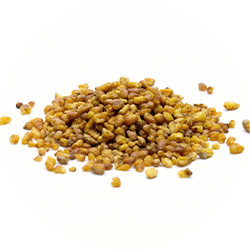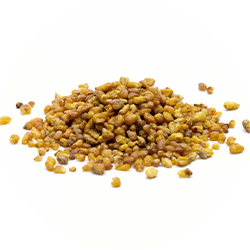WHAT IS JAPANESE TEA?
Types of signature Japanese tea
There are several types of Japanese tea, Matcha and various loose teas.
The variety of delicious flavors come from diverse manufacturing methods and the natural environment.
Tea is great nature gift that is a fusion of many different flavors.
Climates of four seasons in Japan and wide variety of tea trees born as long and hard effort of Japanese tea agriculture also give Japanese teas different characteristics as well as given
by processing technology of Japan and technique of long trained tea masters.
MATCHA
Matcha is a fine powdered green tea harvested and processed in special way.
History of Matcha starts from the tea that the monk Eisai brought back from China in early 11th century, which was powdered and taken as a medicine among aristocrats. Matcha was served in tea ceremonies among Samurai and it linked with Zen was completed as Cha-do in 16th century. Afterwards, Cha-do has been widely popular as a culture unique to Japan.
One of the special processes is shading the tea trees which is method developed in Japan through such poplization period of matcha. Shading from sunlight for 2-3 weeks in April to May increases chlorophyll in the leaves which makes them bright green and full of nutrients, and increases theanine which creates Umami as well.
Then, picked and steamed tea leaves are dried in tencha-ro (a special furnace) without rolling that is typical process to manufacture the Japanese loose teas. These dried leaves called Tencha, teas for grinder in Japanese, is grinded with a mill to be Matcha. Matcha ground with stone mill brings high aroma and fine foam when whisked.
In addition to the elegant aroma and balance of exquisite taste bitterness and sweetness, the way to take in whole beneficial nutrients of tea leaves must be one of the reasons why fans of Matcha are increasing in the world and many variation of Matcha sweets and dishes has been created.
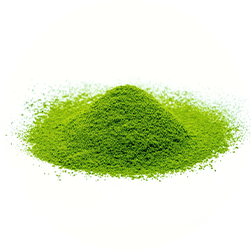
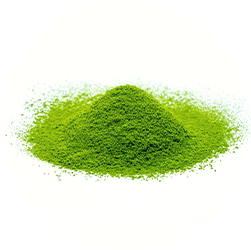
SENCHA
Sencha in the broad sense is “teas to infuse” in Japanese. Here, let’s talk about it in narrow sense.
Sencha is the most enjoyed green tea in Japan. The freshly picked tea leaves are steamed, dried and rolled.
It is a non-fermented tea.
The heat-treated (steamed or roasted) stops the action of oxidative enzymes.
After the leaves have been shaped by rolling. The tea leaves made by this method are called Sencha.
Sencha is green-tinged with yellow and has a well-balanced combination of Umami and bitterness.
High-grade Sencha has more Umami and sweetness when brewed at a lower temperature and steeped longer.

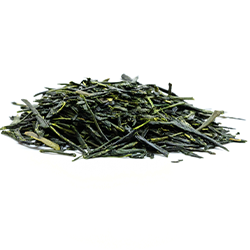
GYOKURO
Gyokuro is the finest grade of Japanese loose tea, having Umami taste best.
Not only Mellow Umami but natural sweetness and mild astringent aroma is created by shading tea trees from direct sunlight for around 3weeks when the sprouts begin to appear.
This process reduces the production of astringency and produces large amounts of amino acid in tea leaves which brings Umami.
To enjoy excellent taste of Gyokuro, steep in smaller water in lower temperature for long. Small teapot and teacups specially designed for Gyokuro make your teatime elegant more.
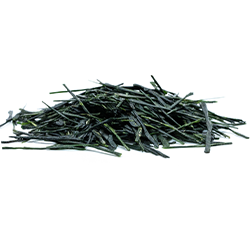

KABUSECHA
Kabusecha is the second-highest grade loose tea after Gyokuro.
As Kabuse cha, Covered Tea in Japanese, is cultivated in similar method to Gyokuro, but the period to shade young tea leaves from direct sunlight is shorter, usually about 4 to 10 days before harvest.
This process makes tea leaves more bright green color and contain less astringency and more flavor of Umami like Gyokuro but has light taste like regular Sencha. Therefore, Kabusecha is said between Gyokuro and Sencha, that means it has good points both of two. Rather affordable price comparing Gyokuro is one of the reason the Kabusecha is made and taken widely in Japan.

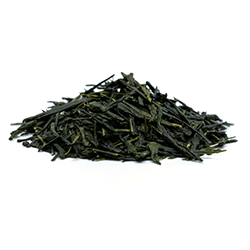
FUKAMUSHI SENCHA (Deep steamed Sencha)
The steaming process is longer than it is for regular Sencha. It is said that the reason to overcome the weaknesses of tea cultivated in warm climate and long daylight hours such as west Shizuoka area, having a good taste but bittersweet taste as well. Therefore, by lengthening the steaming time, they made tea with a mellow taste while alleviates the bitterness and astringency.
As a result of aiming for a delicious tea to drink even if it looks a little worse than it looks and colors, the tea leaves get a broken appearance, and powdery, then heat penetrates the tea leaves and the taste and green color of the tea get richer.
The tea leaves become finer, so the tea leaves themselves contain more when they are brewed and more nutrients from tea leaves can be taken in must be a good point of Fukamushicha.
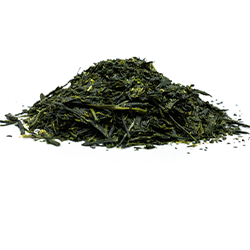
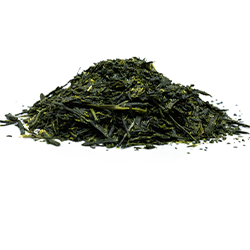
GENMAICHA (Brown rice tea)
Genmai (= brown rice) cha is one of the most popular types of Japanese tea for its savory fragrance of roasted rice and the refreshing taste of green tea mixed into, and only one unique type of traditional tea in Japan that the ingredient which is not tea are blended.
There are various theories about the beginning of brown rice tea. According to one theory, a small crumbs of New Year‘s rice cake broken were roasted and put in tea, then as it was delicious and it started to be commercialized around 100 years ago or so.
Genmaicha has wide variety for the combination of its ingredients, of roasted rice roasted by different degree and time adjusted by producers and Sencha or Bancha or Kukicha mixed.
A cup of Genmaicha has less caffeine than it of Sencha when brewed with the same weight of tealeaves because it contains less tea leaves than Sencha.
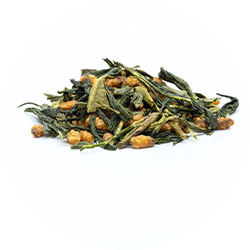
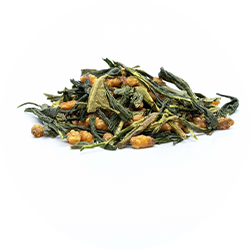
HOJICHA, KUKI-HOJICHA
Hojicha is a kind of green tea made by roasting the loose tea over high flame. Therefore, its color is not green but brown.
The roasting process reduces tannin and caffeine in the leaves and suppresses astringency and bitterness, then its great aroma from warm brown tea makes you relaxed.
It is said that Hojicha was developed to overcome the large inventory of tea of dealer due to the recession around 100 years ago. Nowadays, for its fragrance and refreshing taste good for after meals, we can enjoy variety of Hojicha made from Sencha, Bancha, Kukicha (Stem tea), and by different degree of roasting.
The taste of Hojicha made of leaves has rather strong bodied, and Kuki-Hojicha is lighter-bodied with elegant fragrance.
How about to find your favorite Hojicha that suits your taste?
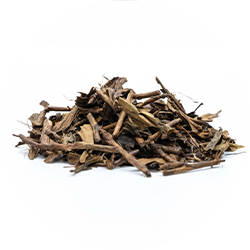
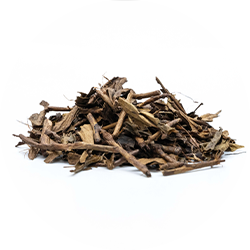
BANCHA
Bancha is one type of green tea mainly made from leaves picked from late summer to autumn. proceeded in the same way as Sencha.
There are various theories about the etymology of “BAN” of Bancha, such as night (=”ban” in Japanese) because of leaves picked in late season, nonstandard (=”ban-gai” in Japanese) because of it positioned low-grade tea.
Bancha is made from grown leaves, so it has high tannin and low caffeine which, give moderate astringent as well as a light and refreshing flavor.
For such taste and easy way to brew to use high temperature water in short time is the reason that Bancha is popular as an everyday green tea to take at and after meals. In some area such as Hokkaido, Tohoku and Hokuriku (the northern part of Japan), Hojicha is called Bancha.

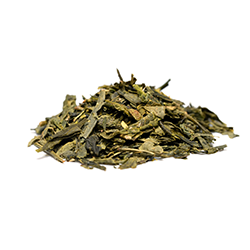
KUKICHA (Stem Tea)
This tea is made of the stems of fresh leaves only sufficiently flavoring sorted during the finishing process of Gyokuro and Sencha as it is.
Kukicha is called “Karigane” in certain area such as Kyoto. It is said that the origin to call Kukicha “Karigane (a kind of geese in English)” is that the stem of the tea leaves is likened to a twig for resting on the sea while the geese are crossing.
Kukicha is characterized by its unique refreshing aroma, sweetness, and less astringency, and is delicious when brewed slightly hot and is easy to pair with any dish.
Therefore Kukicha can be recommended to enjoy taste of high-class Japanese tea with reasonable prices. In addition, compared to other loose tea that tend to get clogged in the mesh of tea strainer or teapot, Kukicha is much easier to clean up afterwards. So Kukicha is not only a great deal but is also a convenient loose tea.
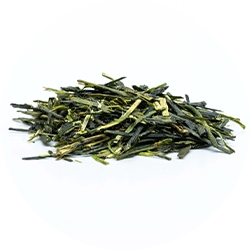
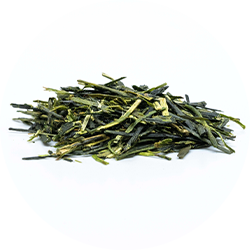
KAMAIRICHA
Almost all Japanese teas are made by steaming fresh leaves then rolling, but Kamairicha is not steamed but fired as its name in Japanese Kama Iri (=fired in a pan) and no process to roll the heated tea leaves, make the shape of Kamairhicha not twisted or straight but round shaped as described by another name “Tamaryokucha (= rounded green tea in English).
Manufacturing of Kamairicha started in Kyusyu in early 15th century based on the method brought by the Chinese potter came to Japan before the manufacturing method of Sencha started.
Therefore, Kamairicha, rare among Japanese green teas, is currently produced almost exclusively in Kyushu.
Kamairicha has clear and golden color of water with sweet roasted aroma and Umami with less astringency.


WA KOCHA (Japanese Black Tea)
We call the Japanese black tea is “Wakocha”, in Japanese, Wa= Japanese, Kocha = Black(exactly red) tea.
The taste is different from teas made in traditional black tea countries for the tealeaves used are the Japanese tea cultivars with improved varieties for green tea but is mild, sweet and less astringency with faint green tea scent and refreshing aftertaste.
Some regions in Japan had produced black tea on a large scale in late 19th century due to the high demand for black tea in the world, but the production of black tea in Japan became very low due to the liberalization of black tea imports in 1971.
But The number of areas producing black tea has begun to increase since the 1990s as demand in Japan increased, then Japanese tea cultivar named Benifuki is developed for black tea and is known worldwide now. This cultivar is used for green tea as well.
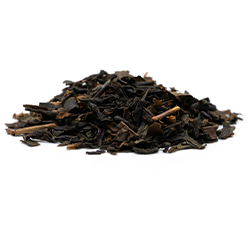
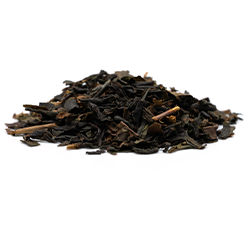
KYOBANCHA
Kyobancha has been popular in Kyoto. The name means Kyoto’s BANCHA, but the taste and aroma are completely different from other Japanese teas including the Hojicha though the watercolor is similar to Hojicha. It is made from large tea leaves and stems sun-dried, roasted and smoked and smoked. without rolling process.
It is characterized by its rough appearance of tealeaves and brown watercolor, strong smoky flavor, but its taste is gentle and refreshing with sweetness.
The common method to enjoy Kyobancha in Japan is not brewed in a teapot but to put it into boiling water in a big kettle and infuse for minutes, then people of all ages has taken plenty of Kyobancha for reduced caffeine and bitterness through the manufacturing process and the refreshing taste. Of course you can brew it in the teapot for small portion.
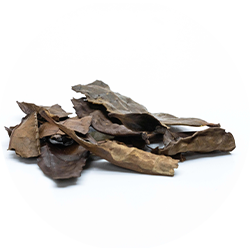

SOBACHA (Buckwheat tea)
“Soba-cha” is made from peeled and roasted seeds of buckwheat having a fragrant aroma and natural sweetness.
There are two types of buckwheat tea.
One is made from buckwheat grown in Japan for a long time, and the other is made from buckwheat originally from the mountainous areas of the Northern Hemisphere called Dattan (=Tartary in English) buckwheat cultivated in China, Nepal, and Mongolia.
It is said that the seeds of the buckwheat “Dattan Soba” contain about 100 times more Rutin than regular buckwheat seeds and it make Dattan Sobacha popular in recent years in Japan.
Its watercolor is beautiful gold color, and does not contain caffeine, so it can be taken both by adults and children, however, be careful for whom having buckwheat allergies.
